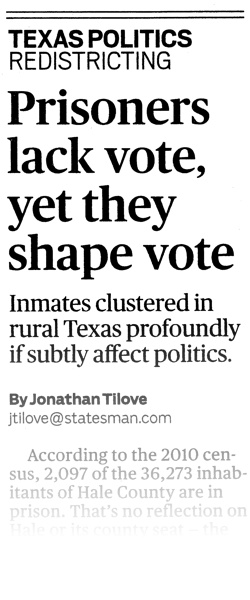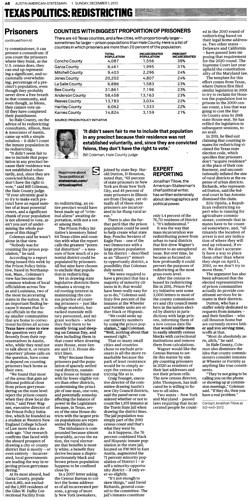Aleks Kajstura joined Bill Newman on WHMP to talk about how prison gerrymandering skews democracy in Massachusetts
by Aleks Kajstura,
December 20, 2013
I joined Bill Newman for a segment on his WHMP show yesterday to talk about how prison gerrymandering skews democracy in Massachusetts.
I explained how the Census Bureau’s method of counting incarcerated people (at the location of the prison rather than where they reside) gives extra political clout to people who happen to live near jails or prisons.
Although each town and the state can take action on its own to solve the problem, a change at the Census Bureau would efficiently end prison gerrymandering across the country as well as in Massachusetts’ town meetings and at the State’s House and Senate. So Massachusetts is currently considering a resolution (S 309) calling on the Census Bureau to count incarcerated people at their home address.
The Census Bureau has asked the states for feedback on its data; it’s time for Massachusetts to let them know we want to end prison gerrymandering.
by Elena Lavarreda,
December 11, 2013
Florida school boards with large prisons should do all they can to avoid allowing the Census Bureau’s method of counting prison populations to dilute the voices of their constituents. Hamilton County School Board has the ability and know-how to protect the rights of local voters, the time to act is now.
The US Census Bureau counts all incarcerated people as though they were residents of the facilities in which they are detained, rather than at their home addresses. This creates big problems for democracy and places an unfair burden on state and local governments — such as cities, counties, and school boards — to find their own solutions. If state and local governments use unadjusted census data for redistricting, they end up with districts or wards that are unfairly padded with incarcerated people who are not local residents and almost all of whom cannot vote. This phenomenon, called “prison gerrymandering,” has the effect of enhancing the weight of the votes cast by people who live near the prison and diluting the votes of everyone else.
We have documented the impact that prisons have had on Florida counties**, and have highlighted the many counties that have chosen to reject prison gerrymandering by removing incarcerated populations when they draw their board of county commissioner districts. It turns out each county in Florida not only has a board of county commissioners, but a school board district too. Census Bureau counts of large prisons cause the same problems for school board districts as they do for counties, and so I’ve been investigating the extent of prison gerrymandering’s impact on Florida school boards. I’ve already found some school board districts in Florida that draw as much as 30% of their “population” from prisons, which creates huge distortions for local democracy. The good news is that as Florida school boards redistrict, they have the opportunity to follow the example of the Florida counties that have protected their democratic process by removing prison populations from their redistricting data.
Hamilton County School Board, for example, is in the process of redrawing their district lines to make sure that all school board residents have equal say in school board affairs. The Suwannee Democrat recently published a piece on the subject. The article states that School Board Attorney, Jay Willingham “[r]eceived a letter from the American Civil Liberties Union stating they were looking at redistricting nationwide because it is unconstitutional to include prison populations in any redistricting calculations.” With the urging of the Florida ACLU, Hamilton County has become savvy to the impacts of prison counts on the fairness of their School Board districts. Consulting with experts and attorneys, Hamilton County School Board has generated thoughtful redistricting research in order to ensure more equitable school board elections.
Continue reading →
Grits for Breakfast argues that Texas should follow its local governments' pragmatic approach to redistricting and avoid prison gerrymandering.
by Aleks Kajstura,
December 10, 2013
One thing I didn’t mention in yesterday’s post about Jonathan Tilove’s article is the coverage it received at the Texas criminal justice blog, Grits for Breakfast: Rural counties treat prisoners as political footballs when drawing electoral districts.
The whole post is worth a read for its frank analysis of Texas’ state and county politics surrounding prison gerrymandering, but its conclusion summarized the state’s failure to end prison gerrymandering best:
…as long as the topic is considered through the lens of state-level partisanship instead of county-level pragmatism, changing it in the near future would be an uphill climb.
Austin American Statesman article by Jonathan Tilove highlights rural Texas counties taking a stand against prison gerrymandering.
by Aleks Kajstura,
December 9, 2013

In a recent article, Prisoners lack vote, yet they shape vote, Jonathan Tilove highlights rural Texas counties taking a stand against prison gerrymandering.
Our recent research shows that local governments see prison gerrymandering as not only unfair, but that it defies common sense. Tilove found much of the same attitude:
“It didn’t seem fair to me to include that population in any precinct because their residence was not established voluntarily, and, since they are convicted felons, they don’t have the right to vote,” said Bill Coleman, the Hale County judge. “If your altruistic goal is to try to make each precinct have an equal number of at least potential voters, and a significant chunk of your population is not allowed to vote, aren’t you sort of undermining the whole purpose of this thing?”
Beyond concerns of equal representation among districts, state and local officials worry that the Census’ data could be used to deny minority representation:
There is also the further peril that the prison population could be used to help create what state Rep. Poncho Nevárez of Eagle Pass — one of the two Democrats with a large prison population in his district — described as an “illusory” minority-opportunity district, a possibility that Coleman duly noted.
“We were required to have a precinct that has a majority of minority citizens in it; that would have been really easy for us to do,” Coleman said. Sixty-five percent of the inmates at the Wheeler and Formby units are either black or Hispanic.
“We could stoke up our minority numbers by using the prison population,” said Coleman. “Well, nothing about that seemed right.”

While local governments in Texas take it upon themselves to reject the Census’ prison count when redistricting, the state still uses the flawed data that counts incarcerated people as if they were residents of the location of the prison. Representative Harold Dutton (D-Houston) and Hale County Judge Coleman refute some common misconceptions about the issue:
The argument has… been advanced that the elected representatives of prison communities actually do provide constituent services for inmates in their districts.
Dutton, who has a staffer solely dedicated to requests from inmates — and their families — who call Houston home but are currently strewn hither and yon serving time, scoffs at that.
“Most do absolutely zero, zilch,” he said.
In Hale County, Coleman also dismisses the idea that county commissioners consider inmates at Wheeler or Formby as anything like true constituents.
“They’re not going to be calling you on the phone or showing up at commission meetings,” Coleman said. “If they do, then you have a real problem.”
New data shows that communities facing the most dramatic potential vote dilution from prison gerrymandering are most likely to reject the Census Bureau’s prison miscount
by Peter Wagner,
December 6, 2013
Drawing a city or county district that contains only incarcerated people who are from elsewhere doesn’t make any sense. Our research for an upcoming law review article on prison gerrymandering in local governments is finding that local governments faced with such absurd predicaments are leading the way in the national movement against prison gerrymandering.
In the decade that we’ve been working with state and local governments to document the extent of, and develop solutions to, the problem of prison gerrymandering, we’ve noticed a strong trend that makes a lot of sense: the bigger the potential problem, the more likely a jurisdiction is to address it. It should therefore come as no surprise that more than 200 communities across the country currently reject prison gerrymandering as seen here:
Continue reading →
Civil rights and good government groups are showing a lot of enthusiasm for ending prison gerrymandering in Ohio. In November, I presented our research to stakeholders and....
by Peter Wagner,
December 5, 2013
Civil rights, civic engagement, and good government groups are showing a lot of enthusiasm for ending prison gerrymandering in Ohio. On Friday Nov 22, I flew out to Columbus Ohio to present our research on how the Census Bureau’s decision to count incarcerated people as residents of the correctional facilities and not of their homes distorts democracy in Ohio. During the presentation, I told the stories of how Maryland and New York built a movement to pass their first-in-the-nation laws ending prison gerrymandering.
Greg Moore of the NAACP National Voter Fund and Deidra Reese of Ohio Voice then led a discussion about next steps. There was a lot of enthusiasm in the room, and I’m looking forward to working with the groups in the near future on a successful campaign in Ohio. Stay tuned to this blog, and to our new Ohio campaign page for more information as it develops.

Greg Moore and Deidra Reese (center) leading a discussion about ending prison gerrymandering in Ohio on November 22, 2013.(Photo: Petee Talley)






